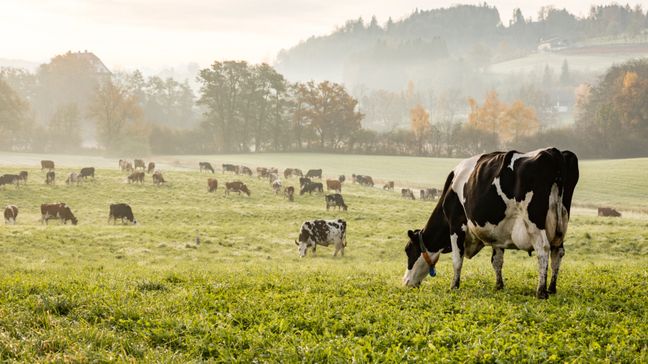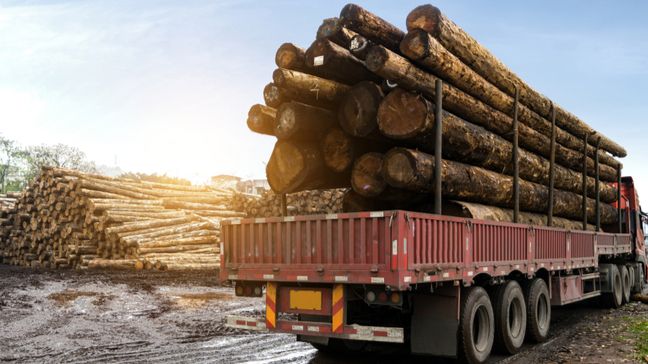Most folks have heard about the typical investing options like stocks, bonds, and real estate. But did you know there’s another booming area where eagle-eyed investors are increasingly seeking their fortunes? That growing investment sector concerns natural resources and precious metals, such as gold, oil, and timber.
You might be unsure of investing in an unfamiliar field. But don’t worry. Once you know the basic principles of how to invest in the stock market, you’ll be ready to explore alternative investment options.
In this guide, I’ll break down everything you need to know about how to invest in natural resources.
What is considered a “natural resource”?

Natural resources are naturally occurring substances and materials that we use—and there are a lot of them. But when it comes to investing, you’ll be looking at a few specific categories. Let’s break them down.
Energy
Ask anyone to name an energy source, and they’ll likely say oil or gas. These fossil fuels power our energy systems. They provide the juice that sustains our daily way of life from the automobiles we drive to the stoves we cook our food on.
The different types of oil include:
- Crude oil.
- Shale oil.
- Oil sands.
- The liquid in natural gas (NGLs).
Mining (rare earth minerals)
Coal and a few other energy sources also fall into the mining category, but this type of natural resource investment often refers to metals mined for making technology.
17 different strategical metals, also known as rare earth minerals, power the frontiers of emerging technology, touching everything from wind power to iPads.
Fine gems
Mining can also refer to gems used in jewelry, like the diamond that usually tops off a pricey engagement ring.
Diamonds don’t work like the stock market. The price of a diamond that you buy won’t necessarily jump 50% between this year and the next. But the price won’t depreciate significantly in the short term, either. They’re a stable, long-term investment.
You can also choose to invest in jewelry companies that sell diamonds, like Tiffany’s, or in diamond mining companies like De Beers. Few ETFs exist for diamond investment, but there are some out there, such as GEMS by FactorShares.
Gold, silver, and other precious metals
For thousands of years—as far back as the Persian Empire—humans have used precious metals to barter, dating back to the Persian Empire.
Gold coins or bullion served as high-status transfers of wealth, while silver played out more in everyday currency exchange. Between the 1870s and World War I, the world’s industrialized economies ran on the gold standard to back up their paper currency.
Gold no longer plays such a formal role in the currency system, but central banks and national governments still retain a little over 17% of the world’s gold as a valuable asset in reserve (according to gold.org). Today, gold sells for 75 times the value of silver and plays a vital role in international transactions — more than you might think.
The most common types of physical gold investments include:
- Collectors’ coins.
- Gold bullion coins (i.e., the American eagle).
- Gold bullion bars.
Lumber (timber)
Wood is required for just about every aspect of our lives. It is in everything, from the paper in our contracts to the material in our IKEA desks. Wood fuels the fires that provide warmth and food for billions of people around the world.
Naturally, then, lumber remains a pretty reliable investment, proving to be less vulnerable to market shocks than agricultural goods or other natural resources.
Agriculture
Feeding all 7.8 billion people on Earth requires constant growth and upscaling of industrial agriculture. Demographers estimate that the world’s population will grow to 9.8 billion people by 2050, this growth will strain the global agricultural sector even further.
As such, farmers rely on genetic engineering techniques, artificial intelligence, and the increasing use of fertilizers to churn out higher quantities of agricultural output.
Within this context, it makes sense to invest in this growing sector. Agricultural stocks vary widely, though some of the most commercially grown and profitable ones include:
- Corn.
- Soybean.
- Palm oil.
- Grain.
Tangentially related stocks in pesticide, biotech/genetic engineering, and fertilizer companies should also be at the top of an investor’s mind.
Water
Water might seem out of place on this list, but, really, water is an essential element needed to sustain life. It shouldn’t come as a surprise that investors care about it.
As individual demand for water goes up, so does industrial demand. Agriculture requires plenty of water, and it takes up approximately 80% of overall water consumption in the U.S. The issue of water shortage becomes even more acute in developing countries.
In the future, the world will likely rely more on companies that extract and produce freshwater, making it a viable investment option.
How to invest in natural resources

You might consider acquiring natural resources directly, but investors typically find other ways to invest in natural resources. Most likely, you won’t purchase natural resources the same way you would buy real estate, for example.
Instead, you’re likely investing in one of the following entities:
- Companies that produce these natural resources.
- Companies that handle the sale or purchase of these resources on the market.
In the rest of this section, I’ll discuss how the different types of investments in natural resources work.
Direct investment
This first method of investing in natural resources may be the least common, but it is also the most straightforward approach. Direct investment entails directly purchasing a commodity.
For natural resources, a direct investment might include:
- Agricultural land.
- Timberland.
- Diamond rings.
- Gold bars.
- Jewelry.
For the average investor, small investments in precious metals, such as collector’s coins or jewelry, may make sense. You can always resell these metals at a time when the market is more favorable. In particular, gold serves as a solid investment, providing decent returns in the long run.
You can purchase gold and jewelry from online marketplaces, auction sites, and dealers. Just make sure that you’re working with a reputable seller—scams are popular in this corner of the industry. The National Futures Association’s Background Affiliation Status Information Center is an excellent tool to confirm a seller’s background.
Likewise, pay close attention to markups above the spot price. Dealer fees can add up fast when it comes to buying natural resources.
But direct investment doesn’t make sense for many types of natural resources. Unless you have deep pockets to invest, you probably won’t have the means to purchase, say, grain or lumber in large enough quantities to turn a profit. You also may not have the time or desire to maintain storage facilities, land, or other property.
Futures and options
If you don’t have the patience or desire to invest long term in the natural resources market, don’t fret. I’ve got you covered in the futures and options market. Let’s quickly refresh the definition of these two terms.
- Futures are high-risk financial contracts that obligate the buyer and seller to purchase stocks at a prefixed price and time. The contract must be honored regardless of what happens to the market after the terms are accepted.
- Options allow a buyer or seller to purchase/sell an asset at a predetermined rate and time but does not force them to do so. These contracts have an expiration date.
What both options and futures have in common is that they are short-term tools used to take advantage of a currently favorable moment in the market. You hedge against long-term risks in the market by capitalizing on short-term gain.
Banyan Publishing Editor John Ross discusses how to maximize short-term gains in the natural resources market with options. You can utilize short-term options to take advantage of temporary downswings in the market (i.e., a sharp drop in oil prices).
Options provide a safer alternative to selling short. If a stock trends downward, it’s easy to fall into the trap of short selling, when you borrow a share and almost immediately sell the stock with the hope of buying it again at a lower price. You pocket the money you earn before returning the share to the original lender.
Here’s the thing about the market though: share prices could rise just as easily as they fall. Then what happens? Then you could lose an enormous sum of money.
If you don’t have a few years of trading experience under your belt, futures and options can be a risky and confusing approach, so you may want to avoid these.
Where to buy futures and options
You have a number of options when it comes to buying futures and options, the most popular of which are CME Group, Eurex, and the London Metal Exchange.
- CME Group is a global market company that includes four exchanges: the Chicago Board of Trade, the Chicago Mercantile Exchange, the Commodity Exchange, and the New York Mercantile Exchange. It is the world’s second-largest derivative exchange and handles the lion’s share of agricultural, energy, and metal trading.
- Eurex is the third-largest derivatives exchange in the world and operates internationally. They are a popular option for agricultural and metal contracts.
- London Metal Exchange (LME), as the name suggests, deals in metal contracts, including precious, minor, ferrous, and non-ferrous options.
One of the best places to buy futures and options is E*TRADE, due to their in-depth research you can access and competitive pricing. They are also one of the largest and oldest online trading platforms. They offer stocks, options, ETFs, mutual funds, and more, all with low trading fees. In addition, they have 24/7 support and an intuitive mobile app.
ETFs
Another great way to invest in natural resources is through exchange-traded funds (ETFs). Below are several different categories of natural resources you can invest in, along with some examples of ETFs you might consider researching further.
Agriculture
- VanEck Vectors Agribusiness (MOO) – Invests primarily in agricultural companies, such as equipment, seeds, supplies, animal health, and transportation providers.
- PowerShares DB Agriculture (DBA) – Deals exclusively with future contracts for farm and ranch commodities.
- iPath Bloomberg Coffee Subindex (JO) – Focuses on corn, soybean, and wheat commodities.
Water
- Invesco Global Water (PIO) – Works mostly with water infrastructure companies and utilities.
- First Trust ISE Water Index Fund (FIW) – Focuses on the potable and wastewater industries.
- Invesco S&P Global Water Index (CGW) – Follows a blended strategy investing in utilities, infrastructure, and water equipment.
Timber
- iShares Global Timber & Forestry (WOOD) – Invests in construction suppliers, forest ownership and management companies, and the production of timber products.
- Invesco MSCI Global Timber (CUT) – Takes a similar strategy as WOOD, except construction suppliers.
Other
- SPDR S&P Global Natural Resources (GNR) – Primarily metals, agriculture, and the energy sector.
- FlexShares Global Upstream Natural Resources (GUNR) – Also focuses mostly on metals, agriculture, and energy, but more on the raw materials (or upstream) side of things.
- iShares North American Natural Resources (IGE) – Invests in everything from oil and gas to timber.
To invest in natural resource ETFs, you’ll need a brokerage account via an online broker or a robo-advisor. The former provides more control, while the latter is more passive and automatic.
Stocks
Not surprisingly, stocks remain the most common way for investors to get started in the natural resources market. Stocks are available in everything from precious metals to solar energy.
Online brokers
If you’re looking for new ways to manage and track stocks in natural resources, consider using online brokers and the best stock tracking apps and websites. These online brokers provide easy investment tools and assistance from finance experts at low commission fees. Online brokers work best if you’re a self-guided individual and can demonstrate confidence in your investing abilities. If this sounds like you, I would suggest opening an account with Robinhood, a commission-free investing platform that offers a bonus for signing up!
Robo-advisors
If you prefer a little less hands-on approach to investing in natural resource stocks, robo-advisors may be a better fit for you than online brokers. Rather than picking your own stocks and putting together a portfolio, you’ll just need to complete a short questionnaire, and a robo-advisor will do the investing for you. A great place to start when looking for the right robo-advisor for your investment goals is Wealthfront, which offers socially responsible investment options in addition to other popular categories like clean energy, healthcare, and technology. Wealthfront makes the list as one of the best robo-advisors.
Alternately, traditional investment advisors offer a fully managed stock experience, but most require higher fees and have higher investment minimums. You’ll need at least $250,000 to get started.
Are natural resources commodities?

According to expert market analyst David Jones, traditional commodities consist of the raw materials that make up the everyday household products or consumable goods we use. These commodities range from the oatmeal that you ate this morning to the smartphone in your hand right now.
Traditional commodities typically fall into one of the following buckets:
- Agriculture.
- Energy.
- Livestock.
- Metals.
An agricultural product like oat makes up your breakfast, while your smartphone contains precious metals. Plus, energy resources, such as oil and natural gas, go into making both your breakfast and your smartphone.
In short, yes, natural resources are indeed commodities.
What are the most valuable natural resources?
If a stranger asked you to name the most valuable natural resource, what would you guess? Maybe sand or a particular metal used in electronic devices? Or perhaps you would pick gold, given its longstanding appeal as an investment and its generally favorable returns in the long run?
Value correlates to demand. Well, according to the experts at Sciencing, the top five natural resources (based on global industrial demand) include:
- Water.
- Oil.
- Forests.
- Iron.
- Coal.
These resources remain the most essential natural products necessary to sustain life for the vast majority of Earth’s population. As such, investing in most of these natural resources may be a safe bet due to their consistent demand in the market.
What is a natural resource company?

Natural resource companies do exactly what you think they would. These companies produce and manage some of the most common natural resources in the world, including:
- Agricultural products.
- Timber.
- Chemicals.
- Minerals.
- And more.
According to Crunchbase, 451 natural resources companies base their operations in the U.S. Some well-known examples include utility companies like Southern California Gas and the oil/natural gas company Antero Resources.
Two types of natural resource companies exist: majors and juniors. Major companies possess more experience, are larger, and turn a hefty profit from their operations.
Junior companies are explorers. These junior companies are hoping to discover a natural resource or have already struck gold and are now seeking to capitalize on it. Investing in junior companies remains riskier, but you could net significant returns if the demand for that natural resource grows.
You can invest in natural resource companies through stocks and other options, which I’ll discuss in a moment.
But it’s smart to keep in mind the natural volatility of this market and the impact on the environment of certain natural resources. Climate change may shift the demand from carbon-heavy natural resources to more sustainable options as environmentally friendly government policies emerge.
Why would you invest in natural resources?
I can think of several good reasons why you would want to learn how to invest in natural resources. Let’s discuss the advantages of investing in natural resources.
Diversifying risk
When stocks and/or bonds are looking weak, you want to seek alternative investment options, such as natural resources.
You develop a more well-rounded, balanced portfolio by diversifying your assets across different investment strategies. Essentially, you’re hedging your bets by investing in natural resources. Not only are you diversifying your assets, but you’re also diversifying your risk, too.
For example, if stocks and bonds in other industries are doing poorly, you may be able to salvage your portfolio with a steady investment in natural resources, which will almost always be in demand.
Another great way to mitigate risk while diversifying your assets is by using a broker that doesn’t charge commissions. Public is a free investing app that offers no-commission trading with no account minimums. You can choose from over 5,000 stock options, and they also allow fractional investing. The platform has a comprehensive support system, a booming social forum, and an easy-to-use interface.
International demand
As economies of developing nations continue their upward growth, demand for new infrastructure will also grow. After all, it takes a ton of lumber, natural gas, oil, metals, and other natural resources to build roads, high-speed trains, and new buildings.
The rise in the global middle-class
As more people in developing countries rise to the ranks of the middle class, their demand for consumer goods, such as refrigerators and cars, will also flourish. Producers require more natural resources to manufacture these goods.
Despite any short-term market shifts, you can reliably predict that opportunities for natural resources investment will only skyrocket in the coming decade.
Political interests drive demand
Fearing shortages, world leaders also acquire crucial natural resources for their citizenry. These political calculations drive demand and make natural resources a viable opportunity for long-term investors.
Why would you not invest in them?
That being said, any investment tactic comes with downsides, and I’d be doing you a disservice if I didn’t acknowledge them.
It’s risky
Okay, so this concern is less specific to natural resources and more applicable to investing in general. The riskiness also depends on consumer and industrial demand for each natural resource. You have to do your homework and decide which one works best for your investing goals based on the market outlook.
For example, if government policies start to break from the production of coal and other polluting fossil fuels toward renewable energy sources, that trend will affect your investing strategy.
It’s pricey (sometimes)
As mentioned, you need a fat wallet if you want to invest directly in natural resources to yield significant returns. A half-acre of forest won’t exactly serve you well in the timber industry.
Then again, stocks and ETFs can provide lower-cost ways to get in the game. In fact, it’s easy to get invested in a broadly diversified basket of ETFs with a robo-advisor like Wealthfront.
It’s a long-term investment
While you can look into futures and options as short-term ways to dive into natural resources, that’s not recommended unless you’re a savvy investor with years of experience. For most investors, natural resources serve as a long-term investment.
Matt Badiali, Editor of Real Wealth, says that the cycles for his natural resource investments typically last 6-18 months and can even go for years on end. If you’re more impatient, natural resources may not be for you.
Then again, you should be taking a long-term approach to your assets already, whether you’re investing in stocks or buying a house. Even day traders need to play the long game. A great way to keep costs down and play the long game is to use a broker like Wealthfront – who is one of the largest robo-advisors in the U.S. They offer a competitive fee structure and free financial planning to help streamline your investing.
Summary
Think to yourself: “what do I want to gain from investing in natural resources?”
If it’s just curiosity or boredom piquing your interest, you should probably take a step back. Jumping into natural resources isn’t something you should do on a whim.
But if you spot a serious opportunity for long-term growth in one of the industries covered here (and it’s within your risk tolerance), why not take a chance?
Also, if you have a vested personal interest in a particular industry, that can also drive your investing goals. The demand for natural resources continues to grow, so there’s always an opportunity on the horizon.


